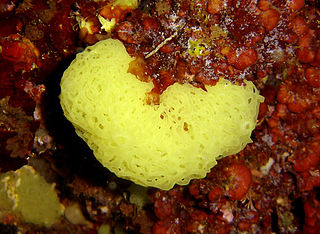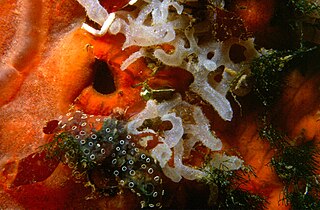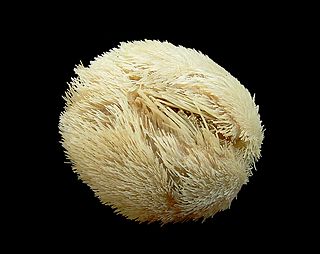
Ernst Heinrich Philipp August Haeckel was a German zoologist, naturalist, eugenicist, philosopher, physician, professor, marine biologist and artist. He discovered, described and named thousands of new species, mapped a genealogical tree relating all life forms and coined many terms in biology, including ecology, phylum, phylogeny, and Protista. Haeckel promoted and popularised Charles Darwin's work in Germany and developed the influential but no longer widely held recapitulation theory claiming that an individual organism's biological development, or ontogeny, parallels and summarises its species' evolutionary development, or phylogeny.

The Noctilucales are an order of marine dinoflagellates. They differ from most others in that the mature cell is diploid and its nucleus does not show a dinokaryotic organization. They show gametic meiosis.

Crown jellyfishes are the six families of true jellyfish that belong to the order Coronatae. They are distinguished from other jellyfish by the presence of a deep groove running around the umbrella, giving them the crown shape from which they take their name. Many of the species in the order inhabit deep sea environments.

Clathrina is a genus of calcareous sponge in the family Clathrinidae. Several species formerly in Clathrina were transferred to the newly erected genera Arturia, Ernstia, Borojevia, and Brattegardia in 2013. The name is derived from the Latin word "clathratus" meaning "latticed".

Leucosolenia is a genus of calcareous sponges belonging to the family Leucosoleniidae. Species of this genus usually appear as groups of curved vases, up to 2 cm long, each ending in an osculum. The overall shape is sometimes likened to a tiny bunch of bananas. They are most often observed in tide pools, clustered around the base of seaweeds or on rocks, and occur in a variety of colours, usually rather pale. Its canal system is of asconoid type. The colony consists of few simple vase-like, cylindrical individuals each terminating in an osculum and united at their bases by irregular horizontal tubes. Leucosolenia reproduces both asexually and sexually. asexual reproduction by budding and sexual reproduction takes place by formation of gametes, i.e., ova and sperms. Lecosolenia is hermaphrodite, because both the gametes are formed in the body of same individual. Sponges are mostly asymmetrical, but Leucosolenia is symmetrical.

Johannes Reinke was a German botanist and philosopher, born in Ziethen, Lauenburg. He is remembered for his research of benthic marine algae.

Monera is historically a biological kingdom that is made up of prokaryotes. As such, it is composed of single-celled organisms that lack a nucleus. It has been superseded by the Four-kingdom system.

Sapphirina, whose members are commonly known as sea sapphires, is a genus of parasitic copepods in the family Sapphirinidae.
Siphonosphaera is a genus of radiolarians. The genus contains bioluminescent species. It is a genus of colonial radiolarians.

Eudendrium is a large genus of hydroids (Hydrozoa), one of two in the family Eudendriidae. These animals are marine cnidarias in the family Eudendriidae.

Rhizostomatidae is a family of cnidarians in the class Scyphozoa.

Candelabridae is a small family of cnidarians within the class Hydrozoa. Myriothelidae Hincks, 1868 and Symplectaneidae Fraser, 1941 are now accepted as synonyms of this family.

Corhiza is a genus of hydrozoans in the family Halopterididae.
John Dow Fisher Gilchrist (1866–1926) was a Scottish ichthyologist, who established ichthyology as a scientific discipline in South Africa. He was instrumental in the development of marine biology in South Africa and of a scientifically based local fishing industry.

Irregularia is an extant infraclass of sea urchins that first appeared in the Lower Jurassic.
Axel Elof Jäderholm was a Swedish zoologist and botanist.

Eleutheria is a genus of hydrozoans belonging to the family Cladonematidae.

Zygophylax is a genus of cnidarians belonging to the family Zygophylacidae.

Cytaeididae is a family of cnidarians belonging to the order Anthoathecata.

















